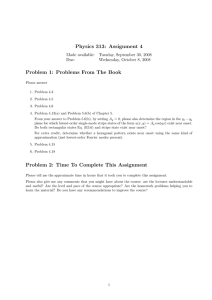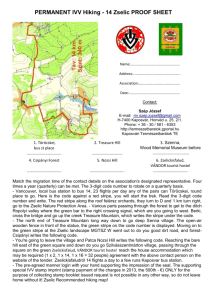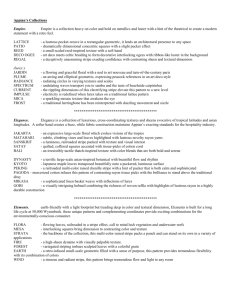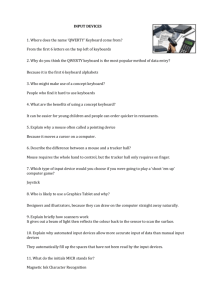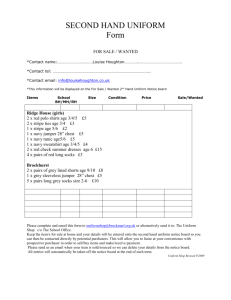ibis2000.doc
advertisement
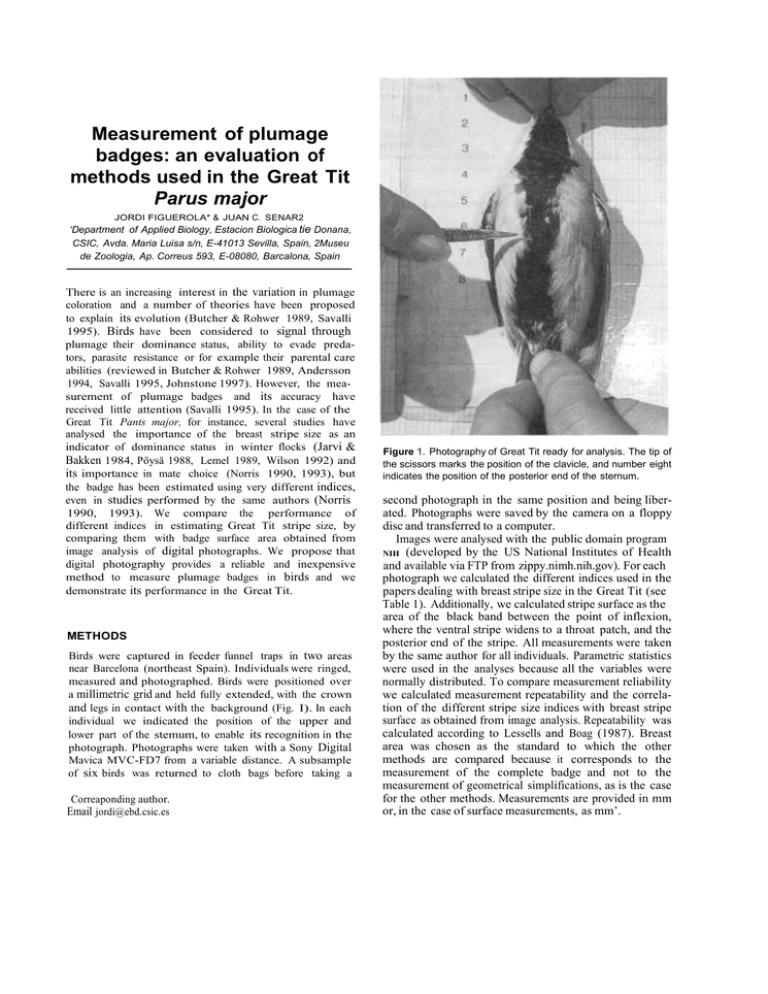
Measurement of plumage badges: an evaluation of methods used in the Great Tit Parus major JORDI FIGUEROLA* & JUAN C. SENAR2 ‘Department of Applied Biology, Estacion Biologica tie Donana, CSIC, Avda. Maria Luisa s/n, E-41013 Sevilla, Spain, 2Museu de Zoologia, Ap. Correus 593, E-08080, Barcalona, Spain There is an increasing interest in the variation in plumage coloration and a number of theories have been proposed to explain its evolution (Butcher & Rohwer 1989, Savalli 1995). Birds have been considered to signal through plumage their dominance status, ability to evade predators, parasite resistance or for example their parental care abilities (reviewed in Butcher & Rohwer 1989, Andersson 1994, Savalli 1995, Johnstone 1997). However, the measurement of plumage badges and its accuracy have received little attention (Savalli 1995). In the case of the Great Tit Pants major, for instance, several studies have analysed the importance of the breast stripe size as an indicator of dominance status in winter flocks (Jarvi & Bakken 1984, Pöysä 1988, Lemel 1989, Wilson 1992) and its importance in mate choice (Norris 1990, 1993), but the badge has been estimated using very different indices, even in studies performed by the same authors (Norris 1990, 1993). We compare the performance of different indices in estimating Great Tit stripe size, by comparing them with badge surface area obtained from image analysis of digital photographs. We propose that digital photography provides a reliable and inexpensive method to measure plumage badges in birds and we demonstrate its performance in the Great Tit. METHODS Birds were captured in feeder funnel traps in two areas near Barcelona (northeast Spain). Individuals were ringed, measured and photographed. Birds were positioned over a millimetric grid and held fully extended, with the crown and legs in contact with the background (Fig. I). In each individual we indicated the position of the upper and lower part of the stemum, to enable its recognition in the photograph. Photographs were taken with a Sony Digital Mavica MVC-FD7 from a variable distance. A subsample of six birds was returned to cloth bags before taking a Correaponding author. Email jordi@ebd.csic.es Figure 1. Photography of Great Tit ready for analysis. The tip of the scissors marks the position of the clavicle, and number eight indicates the position of the posterior end of the sternum. second photograph in the same position and being liberated. Photographs were saved by the camera on a floppy disc and transferred to a computer. Images were analysed with the public domain program NIH (developed by the US National Institutes of Health and available via FTP from zippy.nimh.nih.gov). For each photograph we calculated the different indices used in the papers dealing with breast stripe size in the Great Tit (see Table 1). Additionally, we calculated stripe surface as the area of the black band between the point of inflexion, where the ventral stripe widens to a throat patch, and the posterior end of the stripe. All measurements were taken by the same author for all individuals. Parametric statistics were used in the analyses because all the variables were normally distributed. To compare measurement reliability we calculated measurement repeatability and the correlation of the different stripe size indices with breast stripe surface as obtained from image analysis. Repeatability was calculated according to Lessells and Boag (1987). Breast area was chosen as the standard to which the other methods are compared because it corresponds to the measurement of the complete badge and not to the measurement of geometrical simplifications, as is the case for the other methods. Measurements are provided in mm or, in the case of surface measurements, as mm’. Table 1. Measurements used to study the significance of Great Tit badge size. Repeatability is reported for both sexes and for each sex separately. Pearson correlation between the values obtained with each method and the estimated stripe surface are reported. Reference A B C This study Järvi & Bakken (1984), Poysa (1988) Lemel (1989) D Norris (1993) E Norris (1993) F Norris (1990) G H Method Range Stripe surface (see Methods) Width at the level of the clavicle The product of the two shortest distances between the white cheeks and the yellow breast feathers Estimated as the sum of stripe width measured at four standard points along its length Estimated as the width at the mid-point between the base of the sternum and the anterior end of the stripe Area between the posterior end of the sternum and an imaginary parallel line running 20 mm anteriorly Minimum width Maximum width The sum of stripe width measured at 8 equidistant lines running across the breast Poysä (1988) POysa (1988) Wilson (1992) 304.5—1235.1 4.7—21.6 207.0—659.8 16.4—74.8 2.8—15.9 107.1—428.5 1.8—11.9 13.7—25.9 40.8—138.3 Repeatability Both sexes A B C D E F G H 0.98 0.83 0.91 0.80 0.89 0.89 0.91 0.66 0.86 Males F1112 P 112.6 10.5 22.1 9.1 17.6 18.2 20.6 4.9 13.7 <0.001 <0.001 <0.001 <0.001 <0.001 <0.001 <0.001 0.005 <0.001 0.86 0.08 0.85 0.68 0.91 <0 0.41 0.84 0.39 Females F56 P 12.75 1.18 12.10 5.21 21.31 0.80 2.40 11.57 2.30 <0.005 ns <0.005 <0.05 0.001 ns ns 0.005 ns RESULTS A total of 49 individuals was included in the analyses. We took a second photograph of 12 of these individuals (six males and six females). Repeated photographs for six of these individuals were obtained on the same day and for another six individuals one or two weeks after first capture. Stripe surface was the most repeatable measure (r1112 = 0.98), whereas lower estimates were obtained with the other indices (r1112 between 0.66 and 0.91, see Table 1). A similar picture appeared when repeatabilities were calculated for each sex separately, but in this case nonrepeatable estimates were obtained for females with most of the methods. Correlation of the different measurements with estimated stripe areas was also highly variable, the variation in stripe size explained by these other indices varied from just 49% to as much as 96% (Table 1). 0.79 0.50 0.39 0.20 0.54 0.61 0.60 <0 0.11 Correlation coefficieni F P rp P 8.48 2.98 2.27 1.49 3.33 4.14 3.94 0.43 1.26 <0.05 ns ris ns ns ns ns ns ns 0.81 0.73 0.90 0.70 0.95 0.87 0.77 0.98 <0.001 <0.001 <0.001 <0.001 <0.001 <0.001 <0.001 <0.001 DISCUSSION These results show that it is possible to measure plumage badges with a precision equal or superior to other characters traditionally used in ornithological research, such as wing-, bill- or tarsus-length (e.g. 0.97, 0.78 and 0.97 respectively; Senar & Pascual 1997). Although the magnitude of the possible errors in measuring plumage badges could be high, due to small changes in the distribution of the feathers, it is true that the range of variation in these characters is higher than that found in other morphological characters of birds. In the case of the Great Tit, stripe surface provides a highly repeatable estimate of badge size. Alternatively, other direct measurements could be used. However, none of the other methods proved reliable for measuring female badge size. For sexes combined, the highest repeatabilities and correlations with stripe size were obtained with measurements that should be taken from photographs (like Wilson 1992 index). Norris area measurement (Norris 1990) proved highly repeatable when data from both sexes were combined, but its performance was greatly reduced when each• sex was analysed separately. The measurement of stripe width at four standard points (Norris 1993) provided repeatable estimates with good correlations with stripe surface, and probably constitutes the best index if photography could not be used. Minimum stripe width and width at the level of the sternum proved less reliable but still explained 66—75% of the variation in stripe surface. Three other measures are not recommended. Maximum width, Lemel index (Lemel 1989) and the measurement provided by Norris (1993) for females, showed the lowest (and in some cases only marginally significant) repeatability and/or explained less than 60% of the variation in stripe surface. The selection of badge size index should be made much more carefully for studies dealing with intrasexual variation, since most of the indices showed low repeatabilities in these cases. Nevertheless, badge area remained highly repeatable for both sexes when data from males and females were analysed separately. Digital photography now provides an inexpensive method to measure plumage badges since the economic costs are reduced to that required for the camera, computer and medium used to save the images (1.44 Mb allows storage of more than 30 images). In addition, because the images can be stored, different measurements can be taken long after the bird is released. We are grateful to M.L. Arroyo, D. Bone, J. Domenech and E. Vilamajor for field assistance. This is a contribution to the DGICYT research project PB95-0l02-C02-02. © 2000 British Ornithologists’ Union, Ibis, 142, 482—484 REFERENCES Andersson, M. 1994. Sexual Selection. Princeton, NJ; Princeton University Press. Butcher, G.S. & Rohwer, S.A. 1989. The evolution of conspicuous and distinctive coloration for communication in birds. Curr. Ornithol. 6: 51—108. Järvi, T. & Bakken, M. 1984. The function of the variation in the breast stripe of the Great Tit (Parus majo,). Anim. Behav. 32: 590—596. Johnstone, R.A. 1997. The evolution of animal signals. In Krebs, J.R. & Davies, N.B. (eds) Behavioural Ecology: 155—178. Oxford: Blackwell Science. Lemel, J. 1989. Habitat distribution in the Great Tit Parus major in relation to reproductive success, dominance, and biometry. Ornis Scand. 20: 226—233. Lessells, C.M. & Boag, P.T. 1987. Unrepeatable repeatabilities: a common mistake. Auk 104: 116—121. Norris, K.J. 1990. Female choice and the evolution of the conspicuous plumage coloration of monogamous male great tits. Behav. Ecol. Sociobiol. 26: 129—138. Norris, K.J. 1993. Heritable variation in a plumage indicator of viability in male great tits Parus major. Nature 362: 537—539. Poysa, H. 1988. Feeding consequences of the dominance status in Great Tit Parus major groups. Ornis Fenn. 65: 69—75. Savalli, U.M. 1995. The evolution of bird coloration and plumage elaboration. A review of hypotheses. Curr. OrnithoL 12: 141—190. Senar, J.C. & Pascual, J. 1997. Keel and tarsus length may provide a good predictor of avian body size. Ardea 85: 269—274. Wilson, J.D. 1992. A re-assessment of the significance of status signalling in populations of wild great tits, Parus major. Anim. Behav. 43: 999—1009.

